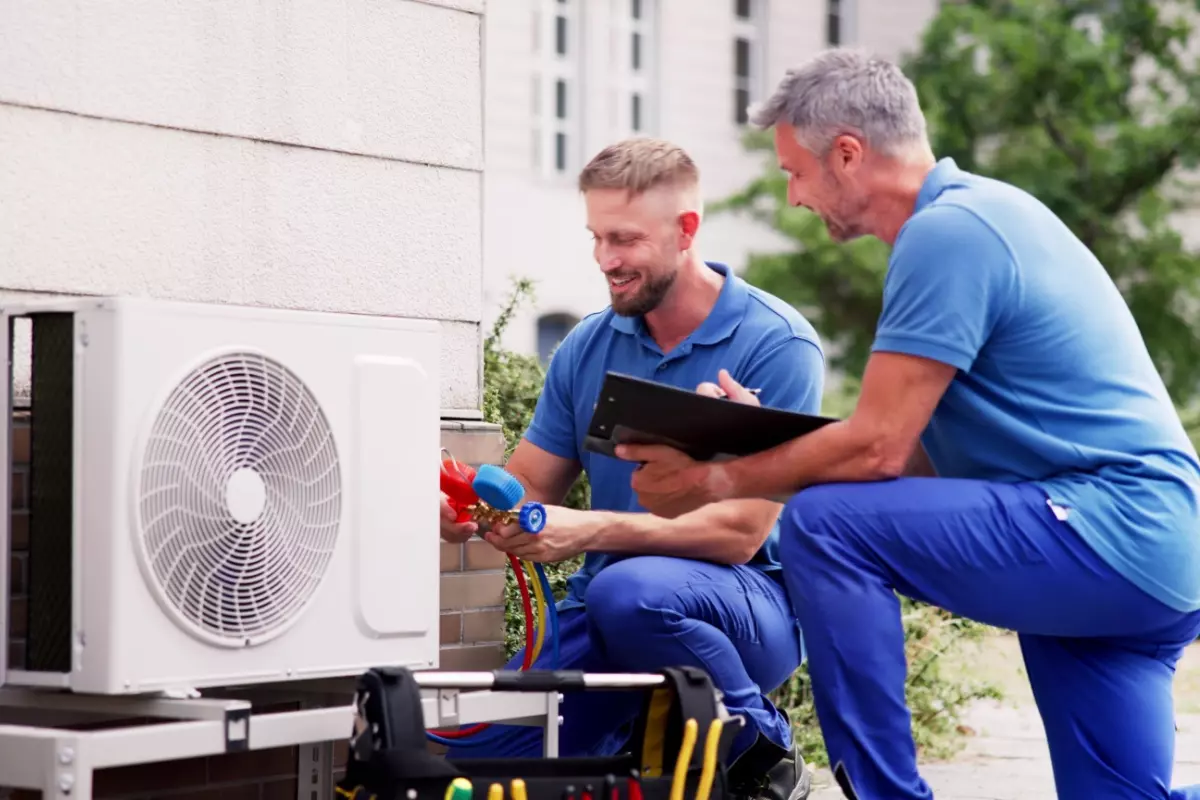Table of Contents
- What’s The Purpose of HVAC Marketing?
- How Much Should HVAC Companies Spend on Marketing and Advertising?
- Traditional Marketing Strategies for HVAC Companies
- Digital Marketing Strategies for HVAC Companies
- Local Marketing Strategies for HVAC Companies
- Pay-Per-Click Advertising Strategies for HVAC Companies
- Customer-Centric Marketing Strategies for HVAC Companies
- Sustainable and Eco-Friendly HVAC Marketing
- Final Thoughts
Are you finding that traditional marketing methods no longer yield the results they once did for your HVAC business? Are you wondering how to leverage the latest marketing trends to boost your visibility and customer base?
From tapping into the dynamics of local markets to leveraging the latest digital trends, we’re here to help elevate your HVAC business to new heights.

Whether you aim to enhance brand awareness, establish trust, or drive sales and growth, our guide covers HVAC marketing strategies to focus on for success.
What’s The Purpose of HVAC Marketing?
HVAC marketing is about strategically positioning your business in a crowded marketplace to ensure it is not only found by potential customers but also chosen and trusted by homeowners and businesses alike. Here’s how HVAC marketing elevates your business:
- Building Brand Awareness: In the HVAC industry, your brand is your promise. It sets you apart from the dozens of other options a customer might have. Effective marketing introduces your brand to potential customers. Above that, it highlights your expertise, reliability, and the unique value you offer – whether it’s 24/7 emergency services, energy-efficient solutions, or unparalleled customer care.
- Establishing Trust: For businesses, trust is everything. Your HVAC marketing efforts should build and reinforce trust by showcasing your certifications, awards, customer testimonials, and success stories. It’s about proving that you’re not just capable of performing HVAC services but that you’re the best and most reliable choice.
- Educating Your Audience: Positioning your brand as an educational platform is a strategic way to highlight your HVAC company as a trusted source. Use your marketing to educate your audience about quality HVAC maintenance, the benefits of energy-efficient systems, and how they can save money in the long run.
- Driving Sales and Growth: At its core, HVAC marketing aims to drive sales and facilitate business growth. You can effectively communicate your value proposition to convert potential HVAC leads into loyal customers. Special offers, maintenance plans, and referral incentives can also play a significant role in driving sales
- Enhancing Customer Retention: Finally, the HVAC industry thrives on long-term relationships. Through marketing, you can stay on top of mind with your existing customers via seasonal promotions, maintenance reminders, and useful tips for keeping their systems running smoothly. This can help retain customers and encourage repeat business and referrals.
How Much Should HVAC Companies Spend on Marketing and Advertising?
It is advised that small to medium-sized HVAC businesses allocate 6% to 12% of their gross revenue to marketing. Bumping this up to 12% to 15% is advisable for those focused on growth or increasing market share.

However, a good chunk of your marketing budget should also go toward digital marketing for HVAC, where customers are increasingly searching for local HVAC solutions. On average, the budget for digital marketing ranges from $2,500 to $12,000 monthly, covering SEO, content marketing, and social media to improve your online visibility.
Traditional Marketing Strategies for HVAC Companies
Despite the digital tools dominating the marketing world, traditional marketing remains a powerful tool for HVAC companies to reach local markets and community recognition. These tried-and-true strategies offer a tangible touchpoint with potential customers, often delivering personalized experiences that digital avenues can’t replicate. Here are some HVAC marketing tips to amplify your business’s presence:
Print Advertising
Your goal with print advertising is to create a tangible connection with your audience, offering them something digital ads cannot — a physical reminder of your brand’s reliability and presence in their daily lives.
- Localized Direct Mail Campaigns: Instead of a broad message, focus on seasonal offerings or maintenance reminders. For instance, before the onset of summer, highlight your air conditioning tune-up services. Include a special offer or discount for first-time customers to encourage action. Leveraging variable data printing technology can help you customize these mail pieces at scale, making each recipient feel directly spoken to.
- Newspaper Inserts with a QR Code: Design an insert that not only talks about your services but also educates the reader on the importance of regular HVAC maintenance. Include a QR code that leads to a video of your team in action or a sign-up page for a free consultation. This approach bridges the gap between traditional and digital, allowing you to track the effectiveness of your print ad through digital means.
- Door Hangers as Neighborhood Announcements: After completing a service in a neighborhood, distribute door hangers in the surrounding area. These should highlight your work (e.g., “Just installed a new energy-efficient HVAC system nearby!“) and offer a discount. This method promotes word-of-mouth and leverages the local project as a testament to your service quality.
Broadcast Advertising
Broadcast advertising allows you to convey your message with the added impact of voice, tone, and visuals.

To ensure your broadcast advertising efforts resonate with potential customers and drive results, here are specialized strategies tailored for the HVAC industry:
- Craft Relatable Scenarios: Develop commercials that depict scenarios your target audience can relate to, such as a family suffering through a hot summer day with a broken air conditioner or the discomfort of a cold, drafty house in winter. These narratives should quickly establish a problem your service can solve, making an emotional connection with viewers. Using real-life testimonials within these stories can further validate your services.
- Leverage Local Weather Forecasts: Partner with local TV and radio stations to sponsor weather segments. You can offer timely tips, such as “Brought to you by [Your Company], reminding you to check your AC unit before the heatwave hits.” This approach not only positions your brand top-of-mind but also associates it with helpfulness and preparation.
- Seasonal Campaigns for Timely Relevance: Time your advertising campaigns to begin several weeks before the onset of extreme weather seasons. Use these campaigns to highlight seasonal maintenance services, emergency repair availability, or energy-efficient upgrades. Creating a sense of urgency by reminding homeowners to act before the first big heatwave or cold snap can drive immediate action.
- Offer Exclusive Deals: Include special offers exclusive to your ads’ viewers. This could be a discounted service call, a free consultation, or a deal on seasonal maintenance packages. Make sure these offers have a clear expiration date to encourage prompt response. Providing a unique code or mentioning that the deal is for a “limited time only” can further incentivize viewers to act quickly.
Broadcast advertising can start as low as $25 for regional TV spots.
Billboard Advertisements
Billboards can build brand recognition and showcase your services in high-traffic areas. Here are tailored strategies to maximize the impact of your HVAC billboard advertisements:
- Location is Key: Choose billboard locations in busy areas where your target market frequently commutes. Ideal spots are near residential areas, shopping centers, and major highways leading into neighborhoods where your services are offered. Consider the direction of traffic and the speed at which vehicles pass to ensure your billboard is easily visible and legible.
- Simplicity Wins: Since drivers or passengers only have a few seconds to absorb your message, your billboard design must be straightforward and impactful. Use bold, readable fonts against high-contrast backgrounds. Your message should be short and to the point, focusing on one key service or offer, such as “Stay Cool This Summer with Our 24/7 AC Repair Services.”
- Leverage Seasonal Changes: Tailor your billboard messages to align with seasonal needs. Highlight air conditioning services in the spring and heating services in the fall. This keeps your advertising relevant and top-of-mind as homeowners begin to think about their upcoming HVAC needs.
Expect to invest anywhere from $750 monthly in rural settings to $14,000 in major metropolitan areas.
Local Partnerships
By collaborating with complementary businesses, you not only tap into their customer base but also strengthen your local network, creating a mutually beneficial ecosystem. Here are some tips to improve your relationships with local businesses:
- Home Improvement Stores: Arrange to have your business cards or flyers displayed at their checkout counters or service desks. In return, you can offer a referral bonus to these home improvement businesses for each new customer they send.
- Real Estate Agencies: Connect with local real estate agencies and offer them special rates for inspecting, maintaining, or upgrading HVAC systems in homes before they go on the market or after they’re purchased.
- Construction and Renovation Companies: These companies frequently require HVAC experts to consult on new builds or to integrate systems into renovation projects. Your business can become their go-to contractor for all HVAC-related needs, from initial consultations to installation and maintenance.
- Local Energy Providers: Collaborate with energy companies to offer energy audits and efficiency consultations. Many energy providers look for reputable HVAC services to recommend to customers seeking to improve their home’s energy efficiency.
Cold Calling
Revamping your HVAC company’s cold-calling strategy can improve the quality of your interactions, increase your success rate, and ultimately grow your HVAC business.

Here’s how you can elevate your existing cold-calling techniques:
- Segment your call list based on potential customer needs, such as residential vs. commercial, new installations vs. repair services, or seasonal requirements. This allows you to tailor your conversation to the recipient’s likely needs, making your call more relevant and engaging.
- Provide your team with local market data, like recent weather trends or energy costs. For example, after a temperature spike, your opening line could be, “With the recent heatwave in [Location], many of your neighbors are upgrading to more efficient cooling systems. We’re offering free consultations to help you assess your options.”
- Shift the focus from selling to educating. Offer advice on maintaining HVAC systems, improving energy efficiency, or preparing for seasonal changes. This approach positions your company as helpful and knowledgeable, building trust with potential customers.
- Update your script to quickly capture interest within the first few seconds. It should introduce who you are and why you’re calling and offer something of immediate value. A compelling question like, “Did you know that an efficiently serviced HVAC system can reduce your monthly energy bill by up to 20%?” can pique interest and open a conversation.
- If a prospect shows interest but isn’t ready to commit, establish a clear follow-up strategy. Offer to send them more information via email, a link to customer testimonials, or schedule a follow-up call at a more convenient time. This keeps the door open for future engagement.
- Employ customer relationship management (CRM) software to track calls, outcomes, and follow-ups. This data can help identify trends, such as the best times to call or which segments are more receptive, allowing you to optimize your strategy over time.
- Mention exclusive offers or limited-time promotions during your call to create a sense of urgency. For instance, “We’re offering a 15% discount on our maintenance package for appointments booked this week. Can I schedule one for you?”
Digital Marketing Strategies for HVAC Companies
A strategic approach to digital HVAC marketing can significantly enhance your visibility, attract more leads, and convert these leads into loyal customers. Here’s how to promote your digital and online marketing for your HVAC business:
HVAC Search Engine Optimization (SEO)
For HVAC companies already navigating the basics of SEO, the next step involves adopting strategies that capture local searches, engage users with dynamic content, and establish your brand as a leading authority in the HVAC sector:
- Dive deep into hyper-local targeting by creating content specific to the neighborhoods, towns, or regions you serve. For instance, create landing pages or blog posts about HVAC challenges unique to certain areas you operate in, like “Best HVAC Solutions for Historic [City] Homes.”
- Plan your content calendar to include seasonal maintenance tips, preparation guides, and services. Use seasonal keywords that potential customers might search for, like “winter furnace maintenance tips” or “preparing your AC for summer.”
- Conduct quarterly technical SEO audits to identify and fix broken links, slow-loading pages, and crawl errors. Ensure your site’s architecture is intuitive, with a clear hierarchy and breadcrumb trails for easy navigation, which improves user experience and search engine crawling.
Content Marketing
Building on the momentum created by a refined SEO strategy, you should also refine your content marketing strategy to further distinguish your HVAC business in a competitive market.

While SEO lays the foundation for visibility, content marketing breathes life into your online presence, engaging potential customers with valuable information that speaks directly to their needs and interests.
- Create comprehensive guides, infographics, and blog posts that cover broader topics related to home comfort, energy savings, and indoor air quality. For instance, a guide on “How to Improve Your Home’s Air Quality” can attract readers interested in health and wellness, broadening your audience.
- Film video content that addresses complex HVAC issues, installations, maintenance, or troubleshooting tips and embed it on your site. Use descriptive, keyword-rich titles and descriptions for these videos. This can enrich your content strategy and meet a growing preference for video content, potentially increasing your site’s time-on-page metrics and engagement.
- Compile a comprehensive FAQ section on your website addressing common HVAC questions using actual customer queries. Implement schema markup for these FAQs, making it easier for search engines to feature your answers in rich snippets. This improves visibility in search results and positions you as an authoritative source.
- Create a section for user-generated tips, stories, and testimonials about their experiences with your services. This can build trust while providing fresh, authentic content that search engines favor.
- Collaborate with local news outlets, community blogs, and industry-specific platforms to publish articles or press releases about HVAC tips, company news, or community involvement.
- Introduce interactive elements like quizzes or calculators on your website. Tools like “Find Your Perfect HVAC System” or “Calculate Your Energy Savings” provide value to users and increase engagement and time spent on your site, signaling to search engines that your content is valuable.
Like your SEO strategies, audit your existing content every quarter and update statistics, advice, and recommendations.
Email Marketing
Email marketing is a tried and true strategy to engage with existing and potential customers, and your HVAC business likely already has a strategy in place to increase your conversion rates. But are you seeing the return on your investment that you would like?

If your answer is no, here’s how you can further refine your email marketing to funnel in more clients:
- Incorporate dynamic content in your emails, which changes based on the recipient’s previous interactions with your services. For example, suppose a segment of your audience has shown interest in energy-efficient HVAC solutions. In that case, your email can dynamically display content related to the latest energy-saving technology or rebates for energy-efficient upgrades. This creates a highly personalized experience, increasing engagement and conversion rates.
- Develop automation sequences that trigger based on specific customer behaviors. If a customer clicks on a link about air purifier installations in your email, follow up with a targeted email detailing a special offer on air purifier services or a case study of a successful installation. This targeted follow-up can significantly increase the chances of converting interest into a sale.
- Incorporate interactive elements into your emails, such as sliders to indicate the age of the recipient’s HVAC system or interactive polls asking what HVAC issue they’re most concerned about. These elements can increase engagement and provide valuable data on your customers’ needs and preferences, allowing for even more targeted follow-up communications.
- Develop a series of educational emails that position your company as the go-to expert in HVAC. Cover topics about your services and broader subjects like the environmental impact of HVAC systems, tips for improving indoor air quality, and how smart thermostats can reduce energy consumption. This approach adds value for your recipients and builds trust in your brand.
- Create special offers only available to your email subscribers, such as priority booking during peak times or discounts on annual maintenance plans. These exclusive incentives can encourage more customers to stay subscribed and pay attention to your emails, increasing the likelihood of them taking advantage of your services.
Local Marketing Strategies for HVAC Companies
One thing to keep in mind is that the services offered by HVAC companies are typically inherently local. Therefore, a well-crafted local marketing strategy can boost your visibility and attract more customers from your community. Here’s how you can leverage local HVAC marketing tactics to stand out:
Google Business Profile
Leveraging your Google Business Profile goes beyond simply claiming your listing; it’s about actively managing and optimizing it to stand out in the HVAC industry.
First, ensure your Google Business Profile showcases high-resolution images of your team in action, before-and-after shots of projects, and any specialized equipment or technology you use.
Next, populate the Q&A feature of your Google Business Profile with questions you frequently encounter, such as inquiries about energy-efficient HVAC services your business offers, range of costs, and your booking policies.
Also, use the posting feature to share updates about your services, special offers, or seasonal promotions directly on your Google Business Profile. This keeps your listing active and engaging, improving its visibility. Posts can also be used to share tips on maintaining HVAC systems, which adds value for viewers and positions your business as a helpful resource.
Finally, if your business uses online booking for appointments, integrate this with your Google Business Profile. This feature not only adds convenience for the user but also streamlines your appointment-setting process.
Local Business Directory Listings
While you’ve likely mastered the art of appearing in big-name directories like Yelp and the Better Business Bureau (BBB), look for niche directories and local business listings specifically tailored for the HVAC and home improvement sectors.
Start by compiling a list of directories focused on HVAC and home improvement services, such as Angie’s List, HomeAdvisor, and Houzz. Next, customize your listing for each directory to highlight your HVAC expertise.
Use high-quality images of your team in action, detailed descriptions of the services you offer, and specific keywords related to HVAC repair, maintenance, and installation. This not only improves your searchability but also showcases your professionalism and attention to detail.
Finally, encourage your satisfied customers to leave reviews on these niche directories. Positive feedback on platforms specifically related to home services amplifies your credibility and rankings on these directories.
Pay-Per-Click Advertising Strategies for HVAC Companies
Pay-per-click (PPC) advertising precisely targets potential customers when they seek your services. But in a competitive field like HVAC, merely activating PPC campaigns isn’t enough.
The real magic happens when you directly address your target audience’s unique demands and seasonal urgencies. With the right strategies, your PPC campaigns can become highly efficient engines driving targeted traffic to your website, resulting in increased bookings and a robust online presence.
Google Ads
HVAC services are inherently local. Therefore, your Google Ads strategy should zero in on hyper-local keywords that potential customers in your specific service areas are searching for. Instead of broad terms like “HVAC services,” focus on location-based keywords such as “AC repair in [City Name]” or “best HVAC contractor near [Neighborhood].”

Utilize Google’s geo-targeting features to ensure your ads are only shown to users in your service areas, minimizing wasted impressions and focusing your budget on leads with high conversion potential.
One of the most effective ways to sharpen the focus of your campaigns is using negative keywords. These are terms for which you do not want your ads to appear. For an HVAC company, this might include terms like “HVAC jobs,” “DIY AC repair,” or “free HVAC training.” By systematically adding negative keywords, you can significantly reduce irrelevant traffic, ensuring that your ad spend goes toward users with genuine service needs.
Think of ad extensions like the extra tools in your HVAC kit — they’re there to help your ad do its job better. First, add your business address to directly show your business’s proximity to potential customers.
Next, put your phone number in your ad, allowing potential customers to reach you with just one click. Finally, use structured snippet extensions to highlight specific services. For example, you can show that you offer “24/7 Emergency HVAC Repair,” “Heating System Installations,” or “Routine Maintenance Checks.” It gives people a quick peek at what you do best.
Facebook and Instagram Ads
To make your social media advertising dollars work smarter, leverage Facebook and Instagram’s advanced targeting options. You can segment and target potential customers based on location, age, behavior, and even the type of property they own.
For example, target homeowners within a 50-mile radius of your service area, aged 30 to 60, who have shown interest in home improvement or energy efficiency. This level of specificity ensures your ads are seen by those most likely to need your services.
Utilize dynamic creative ads to test multiple ad components simultaneously. This feature allows you to combine different images, headlines, and call-to-actions (CTAs) in one ad set, letting the platform automatically find the best combination for your target audience.
For the HVAC industry, this could mean testing images of different HVAC systems, varying headlines highlighting special offers or emergency services, and different CTAs like “Book Now” or “Get a Free Quote.”
For social media post ideas, tap into your existing client base and incorporate customer testimonials and case studies in your ad content. Real stories of how your HVAC solutions have improved comfort or saved money for other customers build trust and relatability.
Facebook’s average cost-per-click is currently about $0.83, while Instagram typically sees a rate between $0.50 to $1.
Customer-Centric Marketing Strategies for HVAC Companies
In an industry where comfort and reliability are non-negotiable, HVAC companies are turning up the dial on customer-centric marketing strategies. These strategies prioritize personalized experiences, responsiveness, and trust to achieve customer loyalty and retention.
Flexible Financing Options
Offering HVAC financing options is not just a service enhancement; it’s a marketing strategy that can significantly boost client acquisition and conversions for your business. By integrating financing solutions, you’re addressing a primary customer concern upfront: affordability.

This strategy can set your business apart, making high-quality HVAC services accessible to a wider range of clients, particularly for those significant investments like full system replacements or major repairs.
When partnering with a Software as a Service (SaaS) provider to offer HVAC financing for customers, select one that offers plug-and-play software. This means the solution should integrate seamlessly into your existing workflows, such as your website and booking software.
This ease of integration ensures that your customers can access financing options easily from your online service booking process.
Also, look for a SaaS provider with a broad lender network specializing in HVAC services. A diverse network means more financing options for your customers, catering to various needs.
Equally important is that this network includes lenders willing to work with a range of credit profiles. This inclusivity ensures that financing is accessible to more of your customers, expanding your potential market.
Moreover, evaluate the lender network’s offerings in terms of financing amounts, terms, promotions, and types of financing available. This variety allows you to market to customers with different financial needs and preferences.
For example, offering zero-interest promotions for the first 12 months can attract customers looking for immediate HVAC solutions without the upfront financial burden.
Incorporating financing options into your HVAC marketing strategy enhances your value proposition. Highlight these options in your marketing materials, website, and social media platforms. Make sure your team is trained to discuss financing benefits and processes confidently.
Feedback and Complaints
Leveraging customer feedback and complaints is like turning a mirror on your HVAC business to reflect both its best features and areas for improvement. Here’s how to make the most of what your customers are telling you, transforming feedback into a tool for growth:
- Establish a systematic approach to proactively gather feedback through follow-up emails or messages post-service. Use surveys with specific questions related to different aspects of your service, like timeliness, professionalism, and satisfaction with the work completed. Make sure these surveys are easy to fill out and submit, encouraging more customers to participate.
- Categorize feedback to identify patterns and areas for action. Positive feedback can be turned into testimonials on your website and social media platforms, serving as real-life endorsements of your service quality. On the other hand, negative feedback can help pinpoint areas needing improvement. But here’s the key: don’t just make changes internally; communicate what you’re doing to address these concerns to your customers. This transparent approach shows that you’re listening and value their input.
- When a customer voices a complaint, respond quickly to acknowledge their concern and express your intention to resolve the issue. This interaction should be as personal as possible; avoid generic responses. Detail the steps you’ll take to remedy the problem and follow up to ensure the customer is satisfied with the resolution.
Sustainable and Eco-Friendly HVAC Marketing
Navigating the path to sustainability is becoming increasingly important in every industry, including HVAC. As customers become more eco-conscious, they’re looking for businesses that offer high-quality services and demonstrate a commitment to environmental stewardship.

This shift presents a unique opportunity for HVAC companies to adapt and thrive by adopting sustainable and eco-friendly HVAC marketing ideas.
Green Certifications
If your HVAC business already has green certifications, it’s time to amplify their value in your communications and promotions, making them a central pillar of your unique selling proposition.
- Whether it’s ENERGY STAR ratings, Leadership in Energy and Environmental Design (LEED) certifications, or specific industry recognitions like the North American Technician Excellence (NATE) certification for energy-efficient installation practices, showcase them on your homepage and About Us page.
- Add certification logos to your brochures, business cards, and social media posts. But go beyond just listing these certifications; create content that educates your audience on what these certifications mean and why they matter.
- Run targeted campaigns that include ad extensions showcasing your certifications to a segment of your target audience searching for eco-friendly HVAC solutions.
Rebates and Incentives
Finally, highlight federal, local, and state rebates and tax credits for energy-efficient HVAC systems and services. These deals can be a driving force in converting eco-friendly clients or encouraging larger sum investments.
- Familiarize yourself with the details of the ENERGY STAR rebates and the specific criteria for qualifying systems. Also, be aware of any utility company rebates that might be available in your service area for the installation of high-efficiency furnaces, heat pumps, or air conditioners.
- Create marketing materials that clearly explain these benefits. Use plain language and avoid jargon to make the information accessible to all customers. Highlight how these rebates can lower the initial cost of installing an energy-efficient system and detail the long-term savings on energy bills. This can be done through blog posts, FAQ sections on your website, and visually engaging social media posts.
- Train your sales team to discuss these rebates and offers as part of their pitch, equipping them with the knowledge to answer any questions customers might have. This approach not only demonstrates your expertise but also shows that you’re looking out for your customers’ best interests, building trust and rapport.
- Offer exclusive company rebates or promotions on top of existing incentives to make your services even more attractive. For instance, you could offer a free energy audit with the installation of any ENERGY STAR-certified system or provide a discount on future maintenance services.
Final Thoughts
A successful HVAC marketing plan revolves around understanding and meeting your customers’ needs – whether through personalized communication, eco-friendly options, or leveraging technology for convenience. Embracing a multi-faceted marketing approach can help your HVAC business not just grow but thrive in a competitive market.
Table of Contents
- What’s The Purpose of HVAC Marketing?
- How Much Should HVAC Companies Spend on Marketing and Advertising?
- Traditional Marketing Strategies for HVAC Companies
- Digital Marketing Strategies for HVAC Companies
- Local Marketing Strategies for HVAC Companies
- Pay-Per-Click Advertising Strategies for HVAC Companies
- Customer-Centric Marketing Strategies for HVAC Companies
- Sustainable and Eco-Friendly HVAC Marketing
- Final Thoughts


